10 Best UX Research Tools for User Researchers [2025]
Explore the top AI-driven UX research tools of 2025 that streamline workflows and enhance user insights for research teams.
![10 Best UX Research Tools for User Researchers [2025]](/content/images/size/w1200/2025/04/image-1744581986533.jpeg)
Looking for the best UX research tools in 2025? Here's everything you need to know upfront:
By 2025, UX research tools are heavily powered by AI, automating tasks like transcription, sentiment analysis, and insight generation. These tools save time, reduce manual effort, and ensure no important user feedback is missed. Whether you're a seasoned researcher or part of a team without dedicated UX experts, these solutions can simplify your workflow.
Top UX Research Tools of 2025:
- BuildBetter.ai: AI-driven insights, real-time transcription, and seamless integrations with over 100 apps. Saves $21,000 per person annually.
- Maze: Rapid testing with AI tools like sentiment analysis and automated themes. Collects 300 responses in under 48 hours.
- Dovetail: Centralized repository for customer insights with AI-powered tagging and pattern detection.
- Looppanel: Simplifies qualitative data analysis with smart transcription and auto-tagging.
- Notably: AI-driven documentation and analysis for qualitative data, cutting analysis time by 50%.
- Userlytics: Global testing panel with advanced usability testing and AI-powered data insights.
- ChatGPT: AI-powered analysis for interviews, sentiment, and thematic clustering.
- Optimal Workshop: Specialized in card sorting, tree testing, and first-click testing for information architecture.
- Betafi: Combines user interviews with advanced feedback analysis and integrations with Figma and Zoom.
- Userberry: Offers a global tester network and tools for preference testing, heatmaps, and user flows.
Quick Comparison Table:
| Tool Name | Best For | Starting Price | Key Features |
|---|---|---|---|
| BuildBetter.ai | AI-driven insights | $7.99/month | Real-time transcription, pattern detection, unlimited seats, 100+ integrations |
| Maze | Rapid usability testing | $95/month | Automated themes, heatmaps, AI-powered follow-ups, fast response collection |
| Dovetail | Centralized insights | N/A | Auto-classification, trend tracking, participant sourcing |
| Looppanel | Qualitative data analysis | $27/month | Smart transcription, AI notes, global search |
| Notably | Research documentation | N/A | AI clustering, custom templates, centralized repository |
| Userlytics | Usability testing | N/A | Heatmaps, sentiment analysis, large testing panel |
| ChatGPT | Qualitative analysis | Free/Pro Plan | Sentiment analysis, thematic clustering, interactive insights |
| Optimal Workshop | Information architecture | $191/seat/month | Card sorting, tree testing, first-click testing |
| Betafi | Feedback analysis | N/A | Multilingual transcription, highlight capture, Figma & Zoom integration |
| Userberry | Global testing panel | N/A | Card sorting, heatmaps, user flow visualizations, tester network in 34 countries |
These tools are transforming UX research by automating repetitive tasks, improving accuracy, and saving time. Dive into the article to learn more about their features and how they can enhance your user research process.
12 Best UX Research & Analytics Tools in 2025 (For Designers)
1. BuildBetter.ai
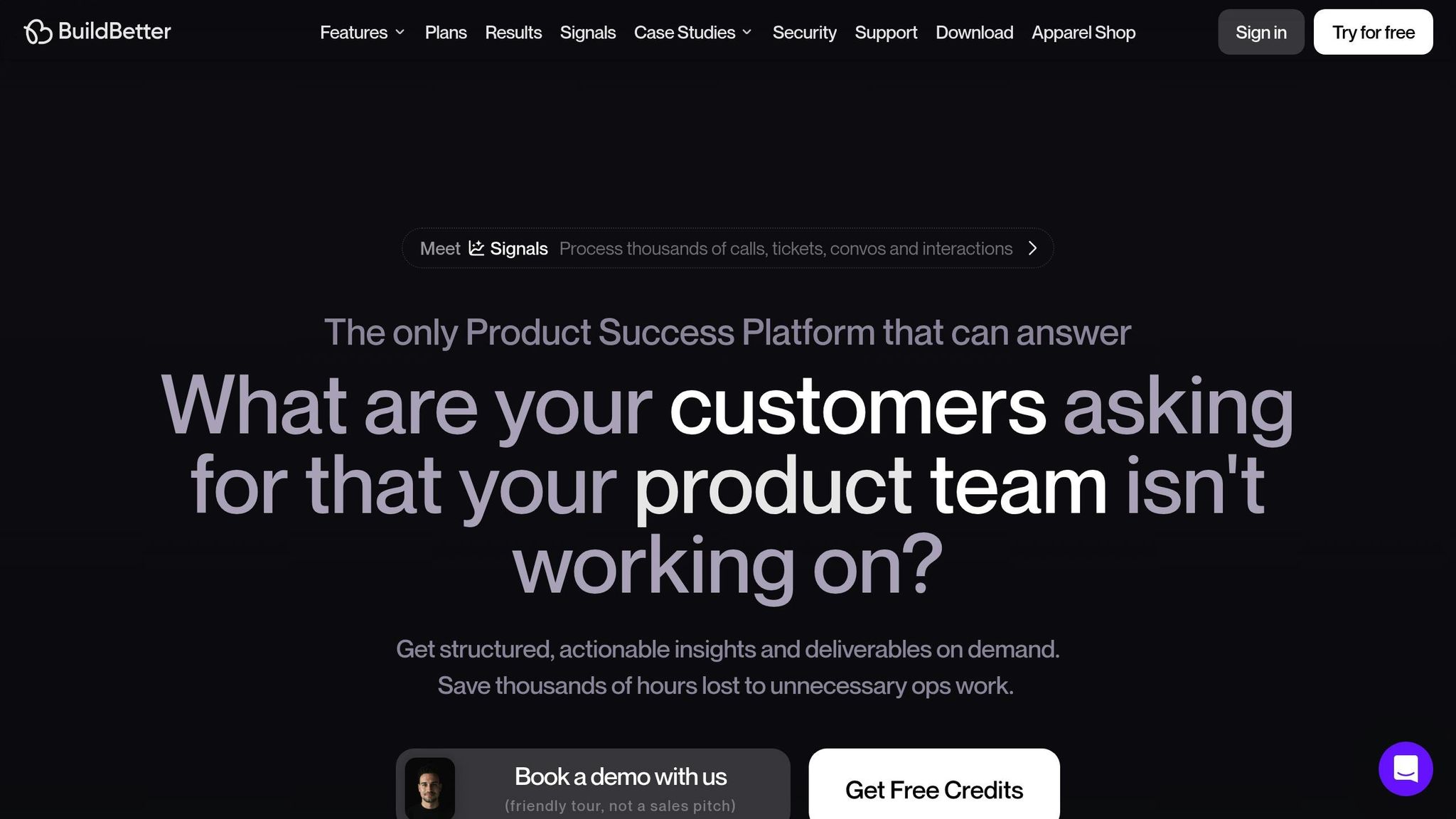
BuildBetter.ai is making waves in UX research by transforming raw user data into insights that teams can act on. Here's what users are experiencing:
- 43% more time spent on revenue-focused tasks
- 18 hours saved per two-week sprint
- 26 fewer meetings every month
- $21,000 saved per person annually (based on $45/hour)
Seamless Integrations
The platform connects with over 100 tools, ensuring compatibility with your existing workflow. Some examples include:
| Category | Supported Integrations |
|---|---|
| Communication | Zoom, Google Meets, Slack, MS Teams |
| Customer Data | Intercom, Zendesk, Hubspot, Salesforce |
| Project Management | Linear, Jira, Asana |
| Documentation | Confluence, Notion, Google Docs |
Features That Stand Out
BuildBetter.ai handles both internal and external data, automatically creating documents like user personas, call analyses, product requirements, user stories, and research summaries. Its automated workflow includes:
- Real-time transcription of user interviews
- Automatic tagging and categorization
- Identifying patterns in user feedback
- Generating polished, stakeholder-ready reports
This streamlined process cuts operational tasks by 40% and decision-making time by 30%, all while maintaining a 98% subscription retention rate.
Trusted by Teams
"We don't operate without BuildBetter. This is the only platform that we use religiously", says Aditya Goyal, Product Lead.
Enterprise-Ready and Secure
The platform is fully compliant with GDPR, HIPAA, and SOC 2 Type 2 standards, offering peace of mind for user data protection. With unlimited seat pricing, it’s a strong choice for enterprise-level research teams.
Next, we’ll dive into Maze and other tools that are also helping teams work smarter in UX research.
2. Maze
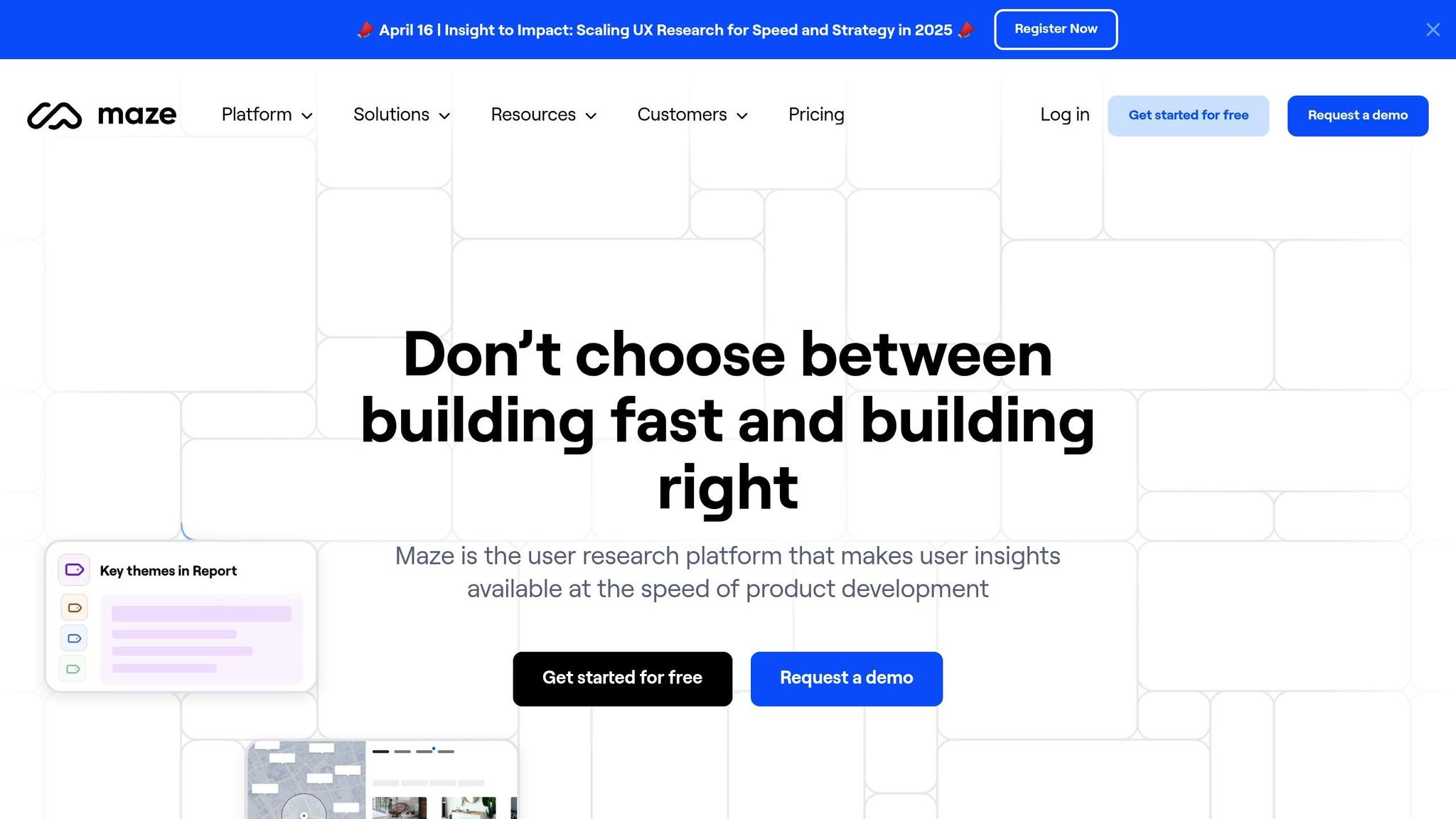
Maze is reshaping how teams gather and analyze user insights in 2025. With over 60,000 teams using its AI-driven tools, it has become a go-to platform for quick user research and testing. Let’s dive into its AI features, speed, enterprise tools, and its impact on teams.
AI-Powered Research Tools
Maze’s AI tools simplify and enhance the research process. Here’s a breakdown:
| AI Tool | Purpose | Benefit |
|---|---|---|
| Perfect Question | Fixes bias and grammar in questions | Ensures higher-quality research |
| AI Follow-Up | Creates contextual follow-ups | Delivers deeper insights |
| Automated Themes | Processes open-ended responses | Speeds up pattern recognition |
| Interview Analysis | Generates transcripts and summaries | Saves analysis time |
Faster Research, Better Results
Maze speeds up research like no other. For instance, using the Reach panel feature, teams collected 300 responses in less than 48 hours. That’s research at lightning speed.
Built for Enterprises
Maze offers tools that cater to large organizations, ensuring security and accessibility across teams. Key features include:
- AI-generated transcripts with summaries
- Visual heatmaps for tracking user behavior
- Detailed path analysis for user journeys
- A centralized research repository
- Collaboration tools for cross-team efforts
"Maze's AI summarization and analysis is a big step up from other solutions we've tried. The quality of insights generated is exceptional and makes our interview analysis process much more effective."
Impact on Teams
Teams using Maze report major improvements in their research processes:
- Faster, data-driven decisions
- Shorter time-to-insight
- Scaled research across multiple teams
- Clear, actionable insights from user conversations
3. Dovetail
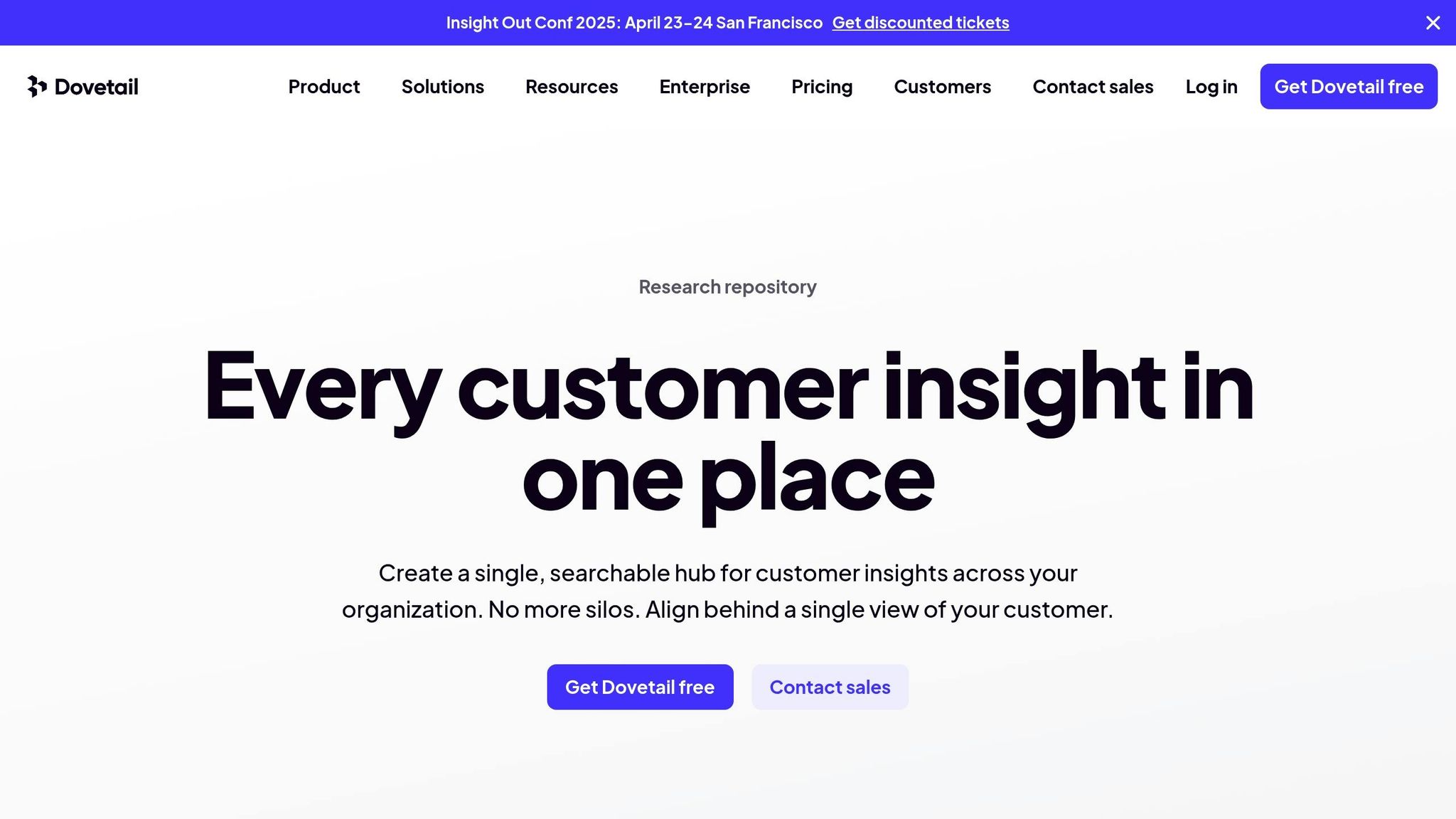
Dovetail serves as a central hub for organizing and analyzing customer insights. Using AI, it simplifies research workflows and enhances efficiency.
AI-Powered Analysis Features
Dovetail incorporates AI to make research faster and more effective. Here’s how its key features work:
| Feature | Function | Benefit |
|---|---|---|
| Ask Dovetail | Answers questions using centralized data | Speeds up decision-making |
| Auto-Classification | Automatically categorizes feedback | Makes tracking trends easier |
| Channels | Identifies recurring themes in feedback | Eliminates manual analysis |
| Recruit | Manages participant sourcing | Simplifies research planning |
These tools are backed by Dovetail's centralized repository, ensuring all insights are easily accessible.
Centralized Research Repository
Dovetail acts as a one-stop shop for storing and accessing customer data, ensuring past research remains useful.
"With Dovetail, the work we've done in the past is always available so that the work we do in the future isn't redundant." - Roy Olende, Head of UX Research
Boosting Research Efficiency
The platform significantly reduces the time spent on research tasks:
"Dovetail reduced my workload from 100 to 10 hours to share out customer insights." - Eric Liu, Product Manager
Enhancing Customer Feedback Analysis
Dovetail excels in turning customer feedback into actionable insights by directly integrating the customer’s voice:
"Channels has helped us uncover important themes for improvement in customer feedback without going through tens of hours of manual analysis."
Privacy and Workflow Standardization
Dovetail supports teams by enabling them to:
- Set strong privacy protocols and securely share data
- Organize research according to their team structure
- Develop consistent research practices
Its seamless integration with other tools simplifies workflows, making it easier for product managers to transform feedback into meaningful insights. By securing data and standardizing processes, Dovetail plays a key role in advancing AI-driven UX research.
4. Looppanel
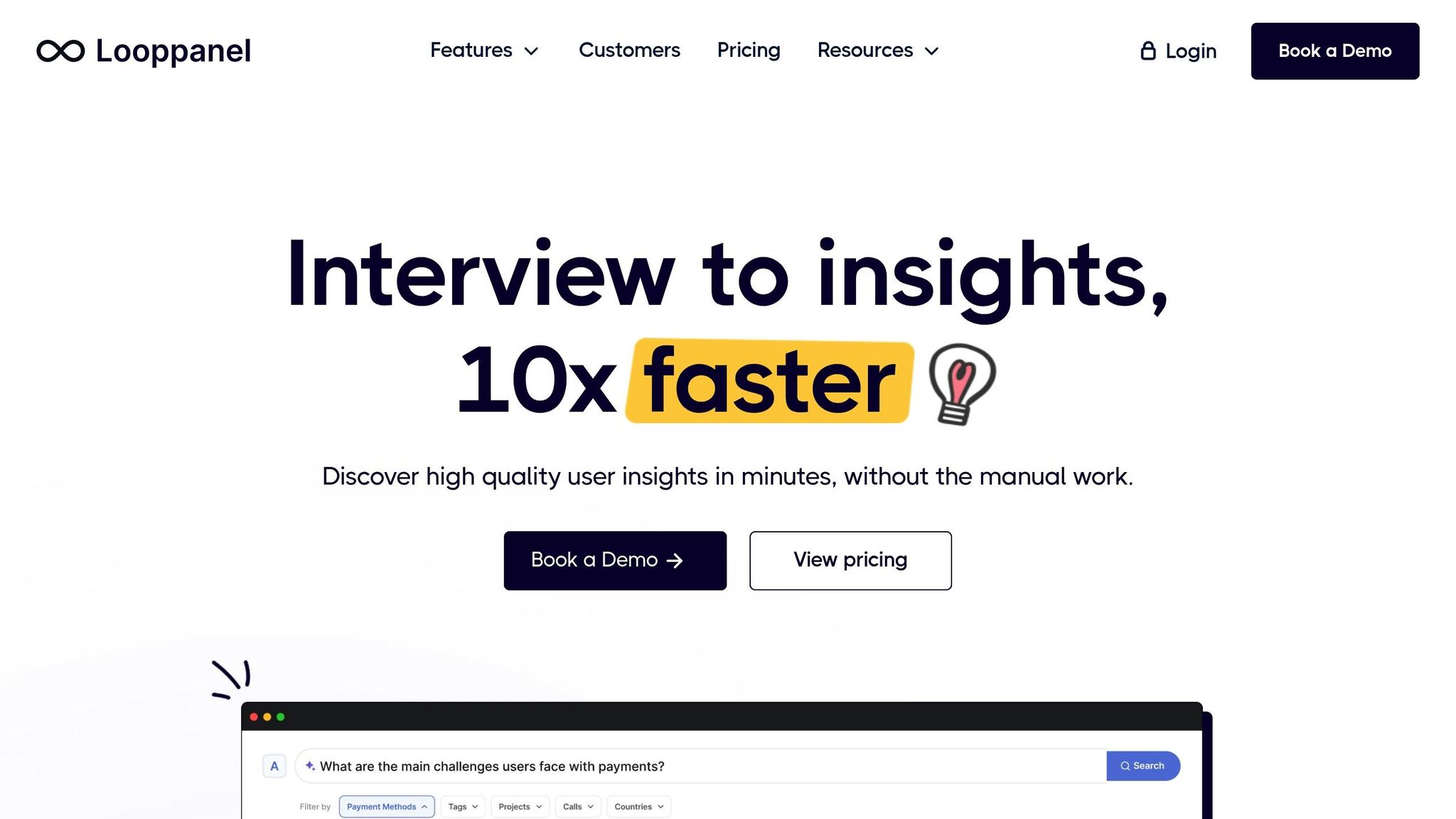
Looppanel uses AI to simplify research analysis, saving time without sacrificing precision. Its tools help researchers make sense of qualitative data more efficiently.
AI-Driven Research Tools
Looppanel offers features that reshape how qualitative data is analyzed:
| Feature | Function | Benefit |
|---|---|---|
| Smart Transcription | Over 90% accuracy across various accents | Minimizes manual editing |
| Auto-Tagging | Automatically identifies themes | Speeds up pattern recognition |
| AI Notes | Links annotations to specific questions | Simplifies the analysis process |
| Global Search | Quick access to insights | Removes research delays |
Faster Analysis, Less Effort
Looppanel dramatically shortens the time needed for analysis. Tasks that used to take two weeks can now be finished in just two days.
"Looppanel is removing half the work I have to do, which is the best thing about it. I love it."
– Trisha Singh, UX Researcher at Redbaton
Easy Team Collaboration
The platform also enhances teamwork by making insights easy to share. Its video snippet sharing feature helps teams stay on the same page.
"The best thing is the ease with which we can share a video snippet which helps our team align."
– Clara Queiros, UX Researcher at Revery Labs
These collaboration tools work alongside a strong security framework.
Built-In Security for Enterprises
Looppanel is designed to meet the demands of enterprise research. It complies with SOC2 Type II and GDPR standards, ensuring data security. Priced at $27 per month, it’s a secure and affordable choice for modern research teams.
5. Notably
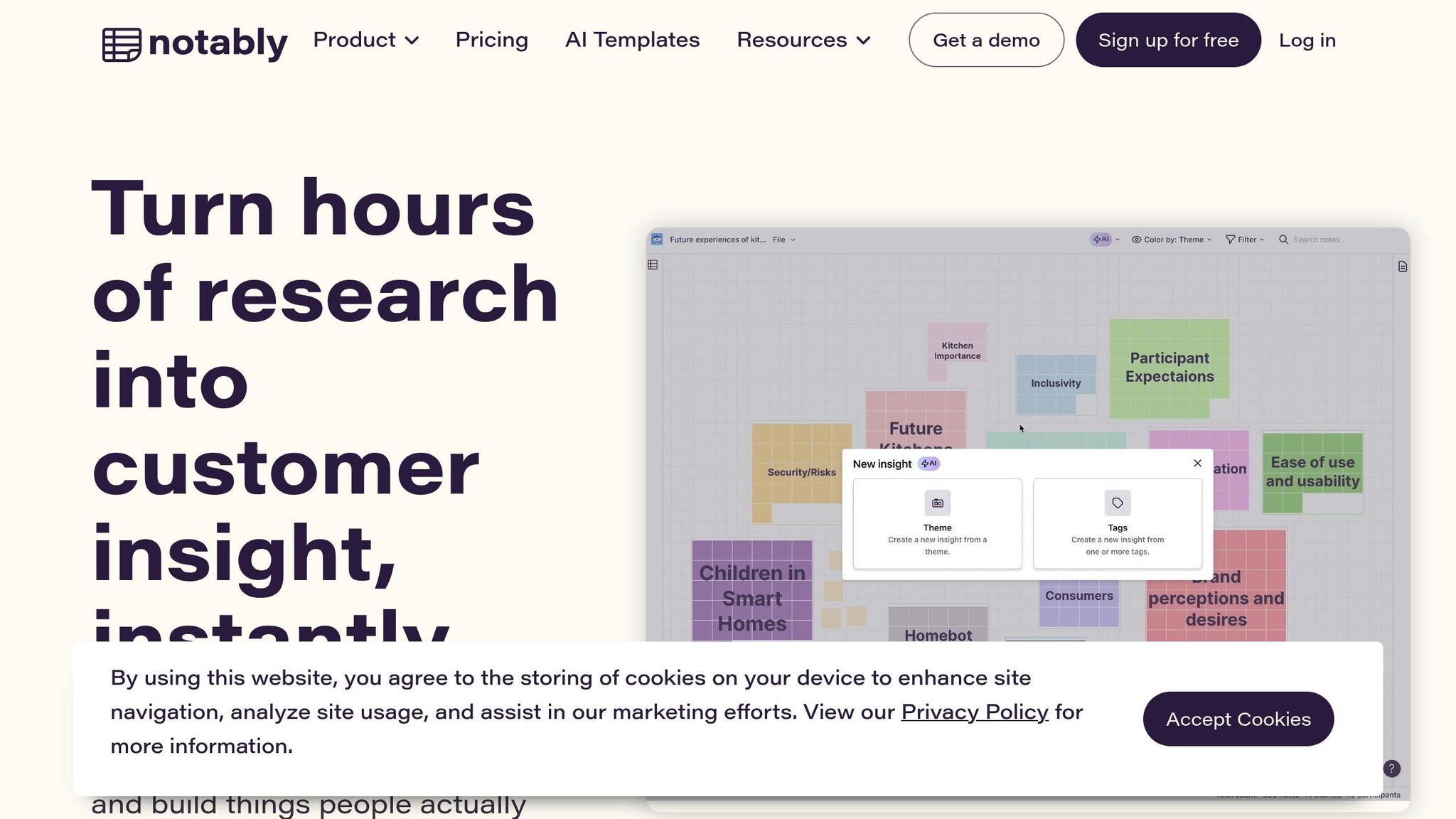
Notably is reshaping research documentation with its AI platform, designed to turn qualitative data into actionable insights for UX teams by 2025.
AI-Powered Research Analysis
Notably uses AI to simplify research workflows, offering features like:
| Feature | Purpose | Benefit |
|---|---|---|
| Instant Highlights | Pinpoints key insights | Cuts down manual review time |
| AI Clustering | Identifies patterns in data | Uncovers hidden relationships |
| Custom AI Templates | Tailors analysis to specific stages | Ensures consistent workflows |
| Automated Tasks | Handles transcription and summaries | Speeds up documentation |
A Centralized Research Repository
Notably acts as a single source of truth for research data, automatically tracking sources and linking related insights. Users have reported a 60% drop in time spent managing data.
"Notably cut my time analyzing user feedback and research interviews by more than 50%. I don't know how I lived without it before." - Laura Maxwell, User Experience Designer
Better Collaboration Through Knowledge Sharing
Notably improves team collaboration by organizing and sharing insights effectively. Key features include:
- Atomic Data Structure: Keeps research insights organized and easy to reference.
- Customizable Workspace: Adapts to team workflows and allows company branding.
- Flexible Access Control: Lets teams set permissions for viewing or editing.
"Notably aligns very closely with this secret sauce design research process we're all doing." - Hannah Mazonson, UX Designer & Strategist
Advanced Documentation Tools
Notably excels at creating clear, shareable research narratives. Its AI-driven organization and presentation tools have won praise from users:
"I love using Notably! It has provided me with resources to compile and analyze my data in an advanced way." - Jolee Edge, User Experience Designer
6. Userlytics
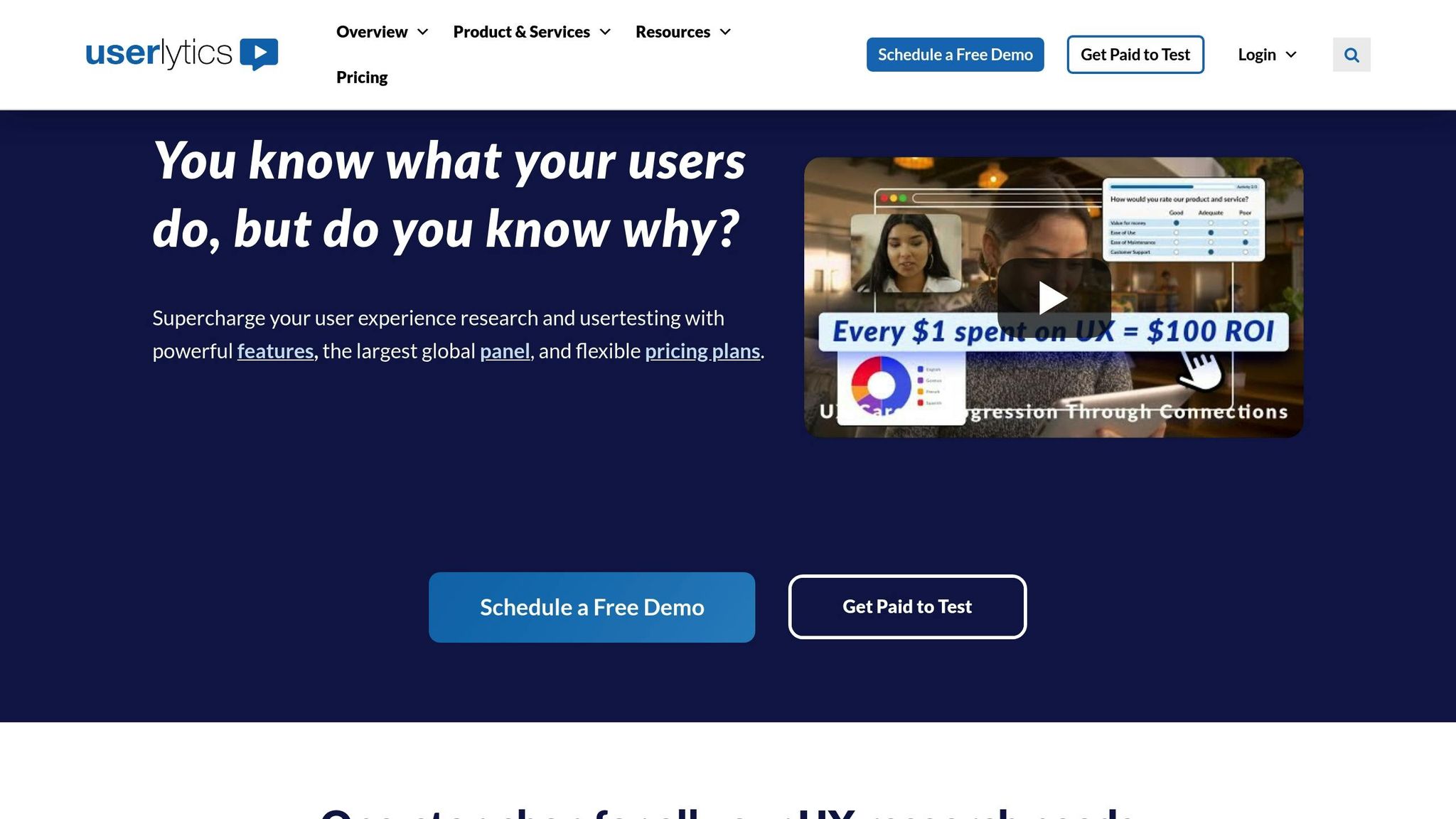
Userlytics stands out in the evolving UX field with its AI-driven research tools and a global testing panel of over 2 million participants.
Advanced Testing Features
This platform offers specialized testing options designed to deliver meaningful insights. Here's a quick look at some of its key testing types:
| Testing Type | Purpose | Benefit |
|---|---|---|
| First Click & Heatmaps | Track initial interactions | Understand navigation patterns |
| X-Second Testing | Assess first impressions | Gauge immediate user attention |
| Desktop Usability Testing | Evaluate desktop usage | Pinpoint friction areas |
| AI-Powered Analysis | Analyze qualitative data | Automate insights extraction |
Integration with Design Tools
Userlytics connects seamlessly with widely-used design tools like Figma and Adobe XD, enabling teams to quickly gather data-driven insights without disrupting workflows.
AI-Driven Research Insights
According to Derrick K., "Customer feedback comes 10x faster and cheaper". The platform’s AI tools analyze user sentiment, usability challenges, emotional responses, and areas needing improvement. These insights, combined with its strong customer support, make it a comprehensive solution for UX research.
Expert Support and Guidance
Userlytics is known for its reliable support and consulting services.
"Outstanding support, great pricing module and love the flexibility of their approach to all projects." - Katalin P.
"Customer service was excellent. Good expertise to get us valuable and actionable insights." - Larry M.
Transforming Research Workflows
"Userlytics has had a major positive impact on our UX Research Projects!" - Cristina R.
Learning Resources
To help teams refine their UX strategies, Userlytics offers a range of educational materials, including whitepapers, blog posts, webinars, podcasts, and case studies. These resources are designed to make adopting best practices easier.
7. ChatGPT
ChatGPT builds on earlier platforms by using natural language processing (NLP) to improve qualitative analysis in UX research. It can quickly pull key insights from user interviews and surveys, turning raw data into practical findings.
AI-Powered Analysis Features
- Interview Transcription Analysis: Summarizes interviews and highlights key points.
- Sentiment Analysis: Evaluates the emotional tone of user feedback.
- Topic Modeling and Thematic Clustering: Spots trends and groups related themes.
Unlike static tools, ChatGPT allows interactive analysis, letting you ask follow-up questions to dig deeper into your findings.
Simplifying the Research Process
You can integrate ChatGPT into your workflow in three simple steps:
- Data Preparation: Clean and format transcripts, removing any sensitive information (about 15 minutes per transcript).
- Analysis Execution: Upload the cleaned data in smaller, manageable chunks (about 15 minutes).
- Results Verification: Review and fine-tune the insights generated (about 10 minutes per session).
Tips for Effective UX Research
- Use clear and specific prompts to guide ChatGPT.
- Divide large datasets into smaller sections for better processing.
- Ask follow-up questions to refine the analysis.
- Replace sensitive details with pseudonyms to protect privacy.
Privacy Guidelines
To ensure data privacy when using ChatGPT, remove personally identifiable information, use pseudonyms, double-check compliance with data protection policies, and carefully review outputs before sharing them.
Applications in UX Research
ChatGPT can assist with a range of UX research tasks, such as:
- Drafting research goals and interview guides.
- Analyzing qualitative feedback.
- Summarizing findings into cohesive reports.
Its ability to handle large amounts of text makes it especially helpful for teams managing extensive research data. By turning raw information into clear insights, ChatGPT simplifies and speeds up UX research workflows.
8. Optimal Workshop
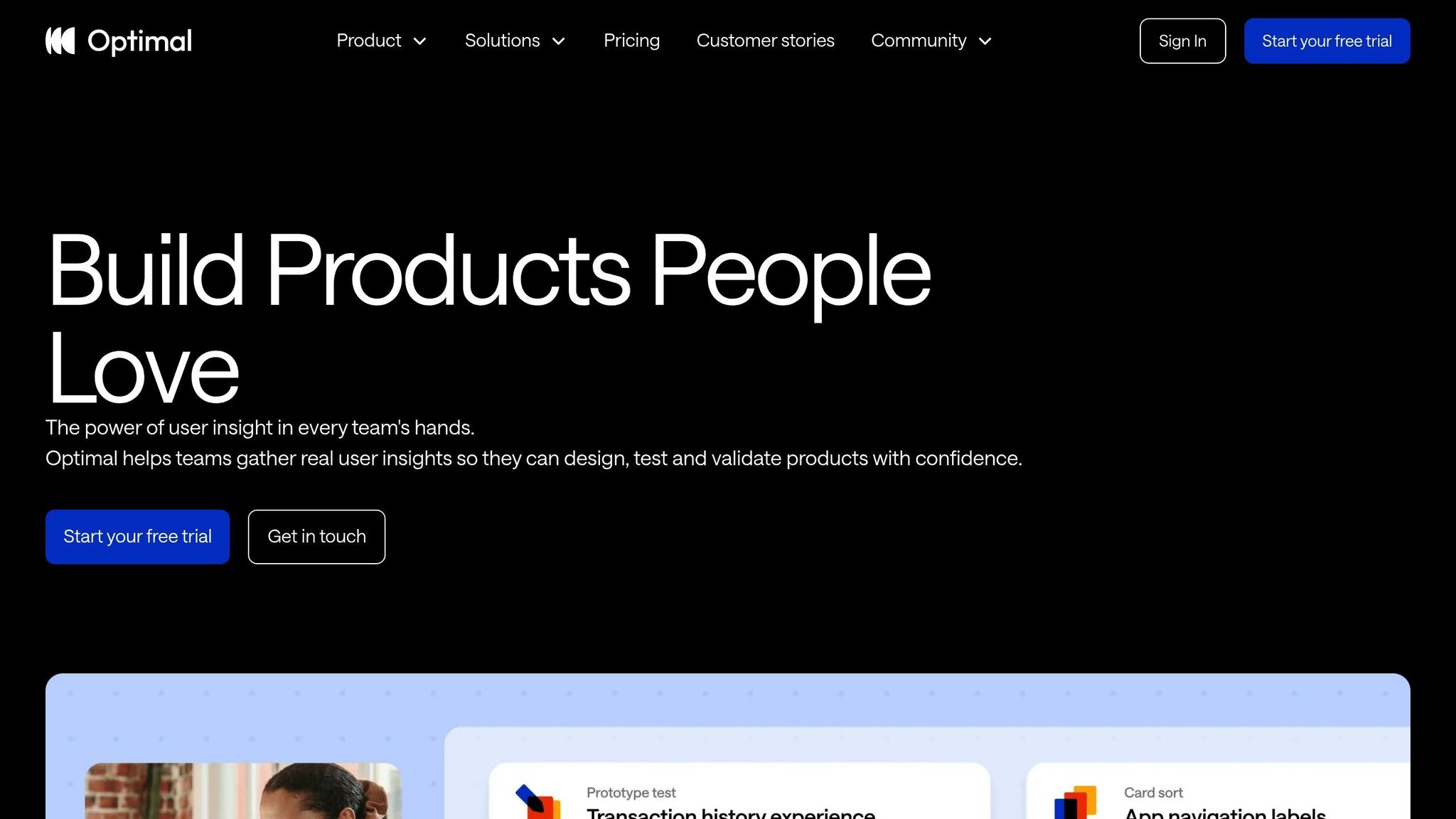
Optimal Workshop simplifies user research and information architecture testing with tools designed to provide actionable data. Its strong security features and GDPR compliance make it a reliable choice for large-scale research efforts.
Key Research Features
Optimal Workshop offers three standout tools that help researchers make informed design decisions:
- First-Click Testing: Tracks where users click first when completing tasks. This helps identify navigation issues early in the process.
- Tree Testing: Allows researchers to test site structures by asking users to locate specific items. This ensures content is organized in a way that matches user expectations.
- Card Sorting: Provides insights into how users group content, which is especially useful for structuring e-commerce product categories or internal knowledge bases.
Practical Application
Richard 'Dice' Allardice, Information Architect at Xero, shared how the platform made a difference:
"Xero is able to answer more queries with content".
This improvement was achieved by using card sorting insights from Optimal Workshop.
Additional Tools for Researchers
Optimal Workshop offers extra resources to support UX research:
- Optimal Academy: Structured learning programs for researchers.
- UX Maturity Model: A framework to evaluate and improve research capabilities.
- Community Events: Opportunities for UX professionals to share knowledge and experiences.
Accessibility and Standards
The platform complies with WCAG 2.1 standards, ensuring that research is accessible to all participants.
Why It Stands Out
Optimal Workshop integrates smoothly into the early stages of design, enabling teams to gather user feedback, refine designs, and scale research across large organizations. This makes it a go-to tool for modern UX research.
9. Betafi
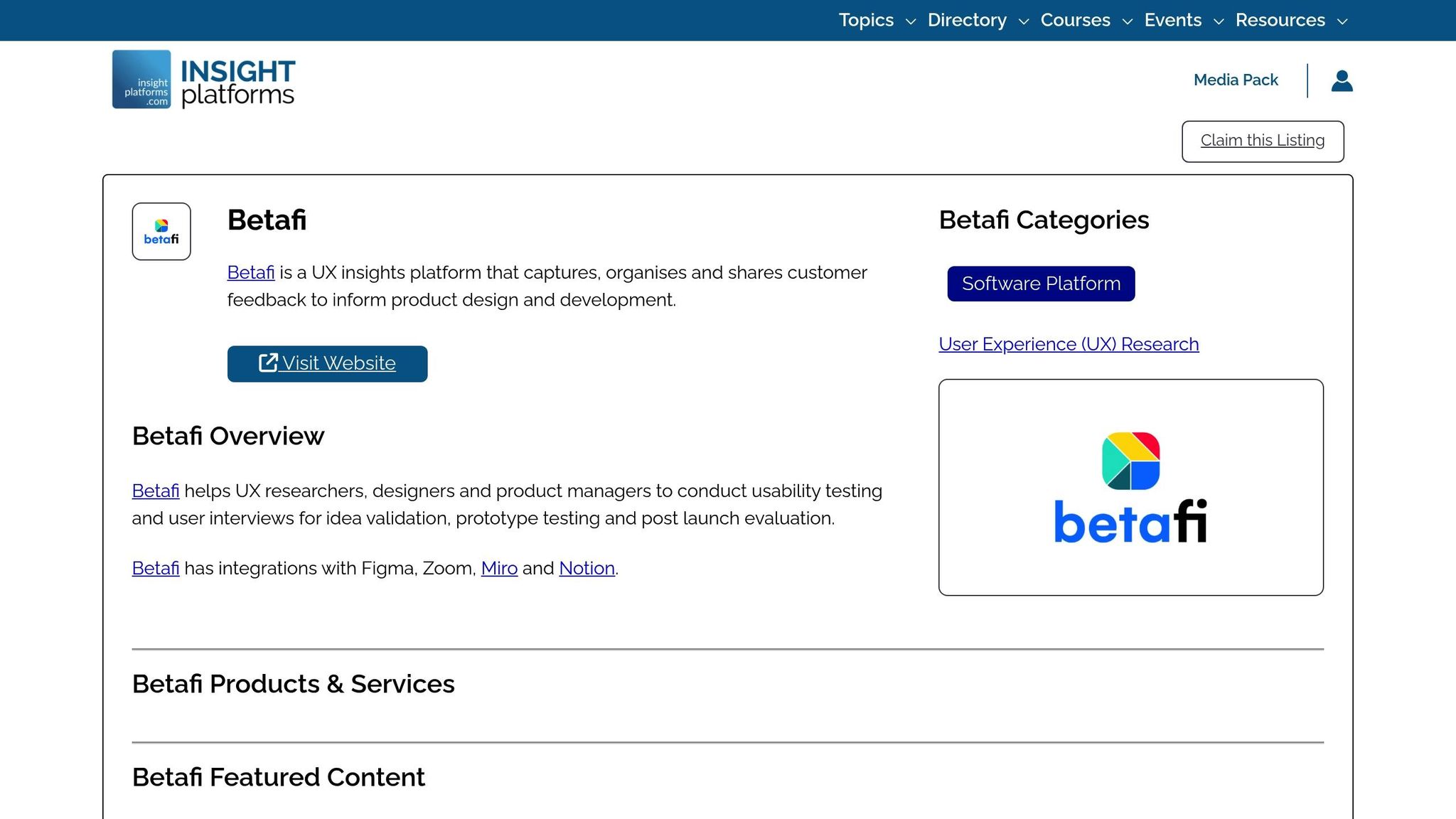
Betafi reshaped user research workflows by combining interview tools with advanced feedback analysis. It earned an impressive rating of 4.94/5 (based on 36 reviews), showcasing its ability to simplify research processes.
Integration with Popular Tools
Betafi made it easy for researchers to connect their work across platforms:
- Design Tools: Direct integration with Figma and Adobe XD allowed researchers to test prototypes within their design ecosystems.
- Meeting Platforms: The Betafi App for Zoom streamlined interviews by enabling real-time insights during live sessions.
- Collaboration Tools: Export options for Miro, FigJam, and Notion helped teams organize and analyze findings efficiently. These integrations reflect the growing trend of connected, AI-powered research tools.
Features for Better Research
Betafi offered powerful tools to gather and analyze user feedback:
- Multilingual transcription in over 30 languages
- One-click highlight capture for key moments
- Structured analysis to identify patterns in user behavior
User Testimonials
Neil Roy, a user researcher, shared his thoughts:
"The thing that stood out for me with Betafi was the Miro, Figma & Notion integrations... I can totally envision 50 conversations giving website feedback, or product/prototype feedback, and getting collated in a structured fashion, would save time for sure."
Kevin William David highlighted how Betafi simplifies research:
"Betafi makes user research joyful. From user interviews to usability testing, we make it easy to capture and share 'aha' moments to achieve product impact."
Streamlining Research Workflows
Betafi helped teams focus on insights rather than juggling tools. With features like automated transcription, quick highlight capture, and seamless exports, it brought structure to even the most complex research projects. While Betafi is no longer available, its features continue to influence modern research tools.
Up next, we’ll take a look at how Userberry pushes UX research forward with its unique approach.
10. Userberry
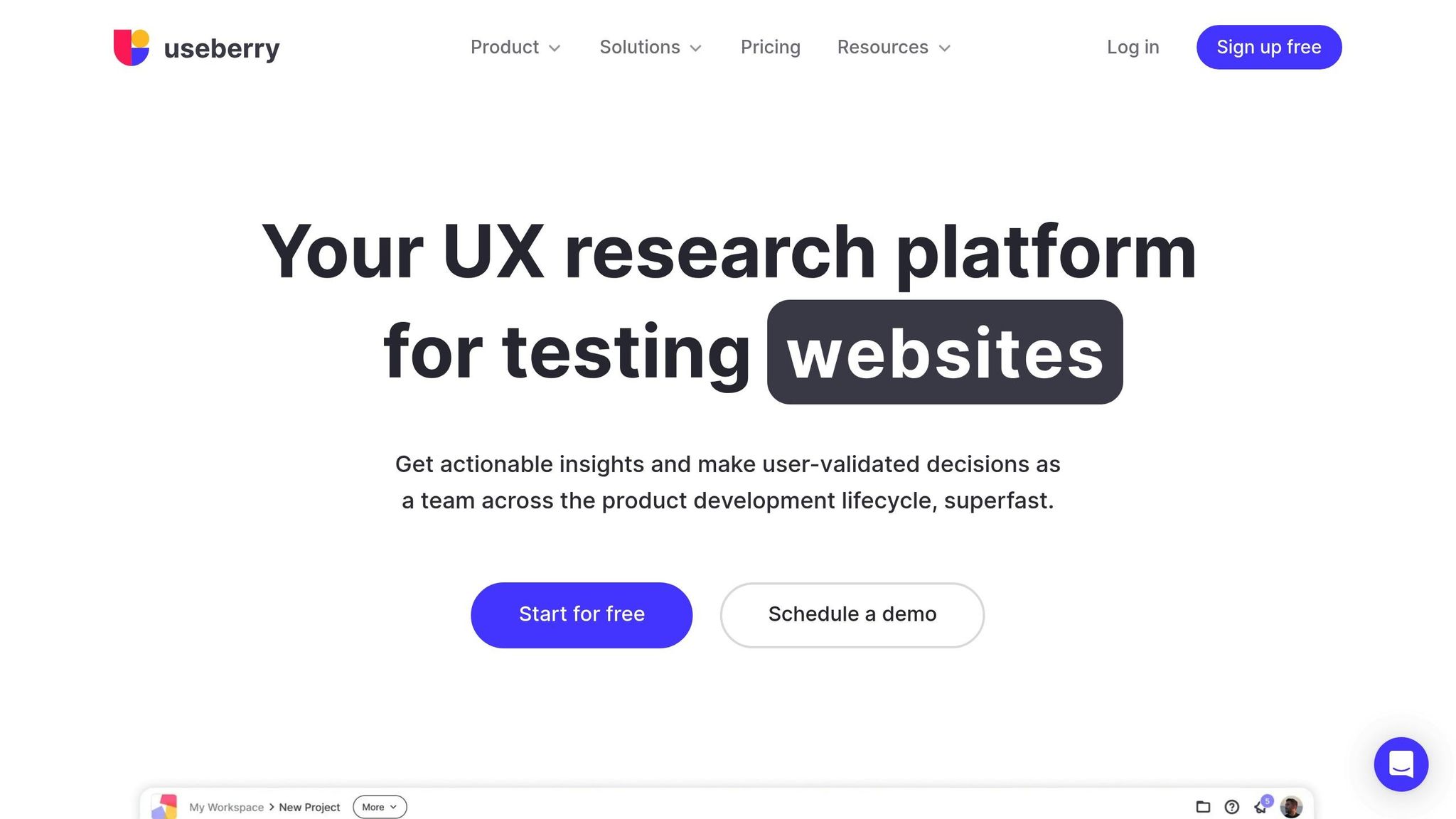
Userberry is a UX research platform designed to simplify testing with a wide range of features and access to a global network of over 120,000 testers in 34 countries. It allows researchers to quickly gather input from diverse audiences.
Advanced Testing Tools
Userberry supports various research methods to help validate design choices. These include card sorting and tree testing for organizing information, first-click and 5-second tests for gauging immediate impressions, preference testing for design feedback, and single-task testing for usability checks. The platform combines data from tools like session recordings, heatmaps, and user flow visualizations to provide both numbers and context.
Built for Enterprise Needs
Userberry integrates smoothly with design tools, making it especially useful for larger teams. Harshad Gehi, Senior Designer at Bayer, shares:
"With its language customization capabilities, Useberry has proven to be a valuable tool for conducting usability tests in our native languages. Additionally, it streamlines the process of collecting usability data by consolidating charts, polls, and responses in one go, which can be accessed with a single click."
Fast and Reliable Data at Scale
For teams working on tight deadlines, Userberry delivers results without compromising data quality. Niklas Johannes, Senior User Researcher at Kroo, notes:
"Useberry enables us to conduct user centered research by delivering high-quality data from a broad range of tests that allow combining self-reports with behavioural tasks. Getting large sample sizes quickly is key in testing different prototypes."
Flexible Recruitment Options
Userberry provides multiple ways to recruit participants. Researchers can either use its panel of verified testers, categorized by hundreds of attributes, or recruit their own through email, social media, or website embeds. Bo Smet, Strategist/Designer at In The Pocket, highlights this flexibility:
"We like the flexibility of Useberry where you can import a Figma prototype, easily set up a test, connect to recruiting tools and get user insights within a day. Combining heatmaps and flow data with survey responses delivers powerful insights."
Features and Pricing Comparison
Let’s break down the key features, pricing, and performance of some top UX research tools based on our in-depth reviews.
Pricing Structure Overview
BuildBetter.ai offers plans starting at just $7.99/month for startups, while team plans are priced at $200/month, including unlimited seats and custom document capabilities.
| Tool Name | Starting Price | Best For | Key Features |
|---|---|---|---|
| BuildBetter.ai | $7.99/month | Product Teams & Researchers | AI-driven analysis, unlimited seats, custom workflows |
| Maze | $95/month | Rapid Testing | Usability testing, surveys, live testing |
| Optimal Workshop | $191/seat/month | Information Architecture | Card sorting, tree testing, first-click testing |
User Ratings for Value and Performance
Here’s how users rate these tools based on ease of use and value for money:
-
Ease of Use
- BuildBetter.ai: 4.8/5
- Maze: 4.2/5
- Optimal Workshop: 4.0/5
-
Value for Money
- BuildBetter.ai: 4.9/5
- Maze: 4.1/5
- Optimal Workshop: 4.3/5
Integration Capabilities
BuildBetter.ai stands out with over 100 integration options, making it easy for teams to sync and analyze research data within their existing workflows.
Enterprise Features
For larger organizations, these advanced features cater to enterprise needs:
-
Security and Compliance
- SOC 2 Type 2 certification
- GDPR and HIPAA compliance
- Custom SSO/SAML
- Advanced permission management
-
Team Collaboration
- Unlimited team members
- Custom workflows
- Automated reporting
- Dedicated success teams
This comparison highlights how AI-powered tools and seamless integrations are transforming the way teams conduct user research, making the process faster and more effective.
Key Takeaways
By 2025, focus on UX research tools that use AI features and workflow automation to deliver measurable results for your business.
Features to Look for in UX Research Tools
When selecting a UX research tool, prioritize these capabilities:
- Efficient Data Handling: Opt for tools that can process a variety of data, such as calls, surveys, and support tickets, without delays.
- Seamless Integration: Look for platforms that connect easily with your current tech stack, including tools like Zoom, Slack, and Microsoft Teams.
- Automated Reporting: Choose tools that can automatically create research reports and maintain consistent reporting schedules.
In addition to these features, pay close attention to security and accessibility.
Security and Accessibility Requirements
Modern UX research tools must ensure data security while being accessible across your organization. Critical features include:
- SOC 2 Type 2 certification
- Compliance with GDPR and HIPAA
- Custom SSO/SAML for secure logins
- Unlimited user access to promote knowledge sharing
These measures not only streamline workflows but also demonstrate clear cost and time benefits.
Measuring ROI
The right tools can significantly improve efficiency and deliver a strong return on investment. Here’s how:
| Impact Area | Improvement |
|---|---|
| Time Savings | 18 hours per sprint |
| Fewer Meetings | 26 less per month |
| Revenue Activities | 43% increase |
| Cost Savings | $21,000 per person annually |
"It wouldn't be possible to do my job at this scale without BuildBetter." - John Strang, Product Operations
Invest in tools that simplify processes and drive productivity.